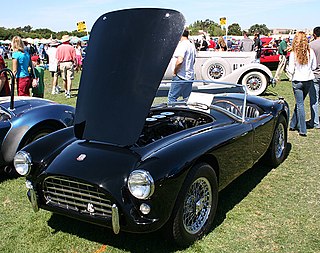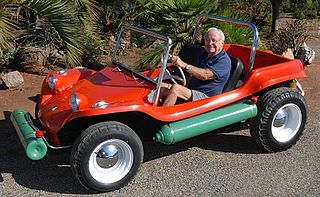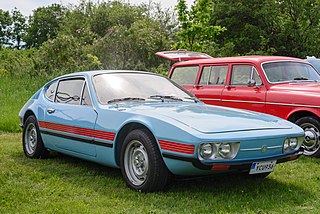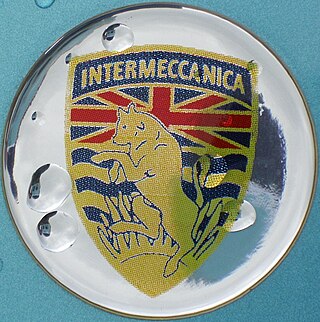
Volkswagen, (VW) is a German automobile manufacturer headquartered in Wolfsburg, Lower Saxony, Germany. Founded in 1937 by the German Labour Front under the Nazi Party and revived into a global brand after World War II by the British Army officer Ivan Hirst, it is known for the iconic Beetle and serves as the flagship brand of the Volkswagen Group, the largest automotive manufacturer by worldwide sales in 2016 and 2017. The group's biggest market is in China, which delivers 40 percent of its sales and profits. Its name is derived from the German-language terms Volk and Wagen, translating to "people's car" when combined.

A kit car is an automobile available as a set of parts that a manufacturer sells and the buyer then assembles into a functioning car. Usually, many of the major mechanical systems such as the engine and transmission are sourced from donor vehicles or purchased new from other vendors. Kits vary in completeness, consisting of as little as a book of plans, or as much as a complete set with all components to assemble into a fully operational vehicle such as those from Caterham.

AC Cars, originally incorporated as Auto Carriers Ltd., is a British specialist automobile manufacturer and one of the oldest independent car makers founded in Britain. As a result of bad financial conditions over the years, the company was renamed or liquidated many times until its present form. In 2022, the new corporate structure began the production of new AC Cobra models, with a slightly modified structure to adapt it to modern safety and technology requirements and obtain the European road homologation certificate.

The AC Cobra, sold in the United States as the Shelby Cobra and AC Shelby Cobra, is a sports car manufactured by British company AC Cars, with a Ford V8 engine. It was produced intermittently in both the United Kingdom and later the United States since 1962.

The Volkswagen Karmann Ghia are a family of three overlapping sporty Volkswagen model series, marketed in 2+2 coupe (1955–1975) and 2+2 convertible (1957–1975) body styles, though German production ended one year before that in Brazil. Internally designated the Type 14 (1955–1975), the Type 34 (1962–1969), and the Type 145 TC, the Karmann Ghia cars combined the floorpans and mechanicals of the Type 1 / Beetle or Type 3 'ponton' models with styling by Italy's Carrozzeria Ghia, and hand-built bodywork by German coachbuilding house Karmann.

AC Ace is a car which was produced by AC Cars of Thames Ditton, England, from 1953 until 1963.
Wilhelm Karmann GmbH, commonly known as Karmann, was a German automobile manufacturer and contract manufacturer based in Osnabrück, Germany. Founded by Wilhelm Karmann in 1901, the company specialised in various automotive roles, including design, production and assembly of components for a wide variety of automobile manufacturers, including Chrysler, Porsche, Mercedes-Benz and Volkswagen Group.

The Volkswagen Type 3 is a compact car manufactured and marketed by Volkswagen from 1961 to 1973. Introduced at the 1961 Frankfurt International Motor Show, the IAA, the Type 3 was marketed as the Volkswagen 1500 and later as the Volkswagen 1600, in two-door Notchback, Fastback, and Variant body styles, the latter marketed as the 'Squareback' in the United States.

The Meyers Manx dune buggy is a small recreationally-oriented automobile, designed initially for desert racing by Californian engineer, artist, boat builder and surfer Bruce F. Meyers. It was produced by his Fountain Valley, California company, B. F. Meyers & Co. from 1964 to 1971, in the form of car kits applied to shortened chassis of Volkswagen Beetles. The car line dominated dune racing in its time, breaking records immediately, and was eventually also released in street-oriented models, until the company's demise due to tax problems after Meyers's departure. New vehicles inspired by the original Manx buggy have been produced by Meyers's re-founded operation, Meyers Manx, Inc., since 2000. The name and cat logo of the brand derives from the Manx cat, by virtue of the tailless breed's and the shortened vehicle's truncated "stubbiness".

The Volkswagen SP2 is a sports car that was developed by Volkswagen do Brasil and built from July 1972 until December 1975. It is based on the chassis of the Brazilian market Volkswagen Type 3. "SP" is said to be an initialism of São Paulo, where the car was built, or of "Sports Prototype". In its issue of 20 June 1973, German technology magazine Hobby called the SP2 the "most beautiful Volkswagen in the world."
The Mania Spyder was a Swedish kit car company in Falköping selling a sports roadster based on either VW Beetle or spaceframe chassis. They advertised that a formula spaceframe made for motorcycle engines would be available in spring 2001. It was designed by the automotive designer and guitar builder Ulf Bolumlid of Design by Ulf. Over 50 examples of the Mania have been sold, a Swedish record for an own design kit-car.

Intermeccanica is an automobile manufacturer, founded in Torino, Italy, in 1959 by Frank Reisner. It subsequently moved first to the United States, then to Canada, and is currently headed by Frank's son, Henry Reisner.

Falcon Shells was a British company that produced specials/kit cars from 1956 until 1964.

John Tojeiro, affectionately known as Toj, was an engineer and racing car designer whose innovations helped to revolutionise car design in the 1950s and 1960s.
Fiberfab was an American automotive manufacturer established in 1964. Starting with accessories and body parts, they progressed to making kit cars and fully assembled automobiles. They became one of the longest lasting kit car manufacturers.

Kelmark Engineering was an American automotive specialty shop established in 1969 and based in Okemos, Michigan. It focused on high-performance custom V8 drivetrain swaps, the modification and production of rear and mid-engined cars, and custom-built turn-key automobiles. Until 1986, Kelmark Engineering manufactured kits and complete, finished, turn-key vehicles which were either Volkswagen-based or built on tubular race car-type frames. The outfit gained its name from Russ Keller and Randy Markham, the two co-creators who started the operation. Up until at least 1989, the Kelmark GT was still available as a kit albeit the manufacturer was Kelmark Motors in Holt, Michigan. The cars are all "rare" models, but the Volkswagen-powered Kelmark GT was the most popular.

New Zealand had a long history of small garages and vehicle enthusiasts modifying and creating sports and sports racing cars. Out of these interests grew the New Zealand kit and replica car industry with the introduction of fibre-glass car bodies in the 1950s.
Embeesea Kit Cars was a British kit car manufacturing company, based in High Wycombe, Buckinghamshire, operational 1975-1983.

RW Kit Cars Ltd. was an English manufacturer of kit cars, founded in 1983 by Roger Woolley.

The Siva Motor Car Company was a British manufacturer of automobiles active from 1970 to 1976.
















